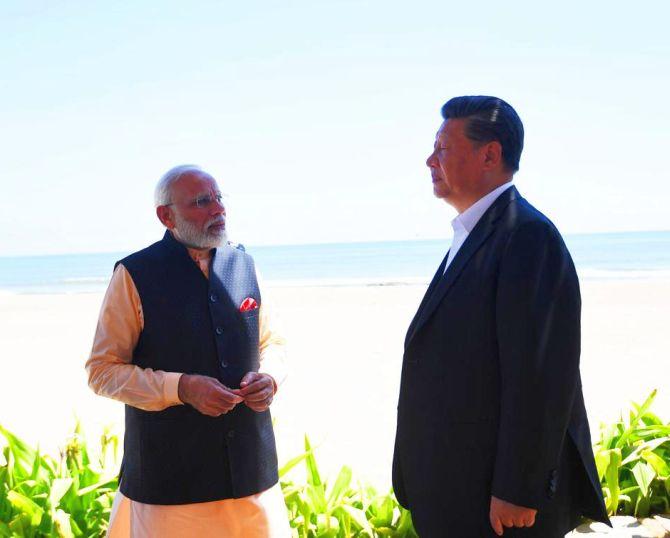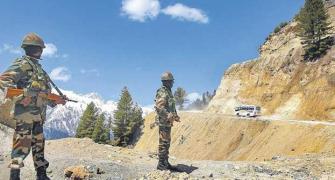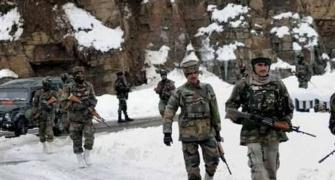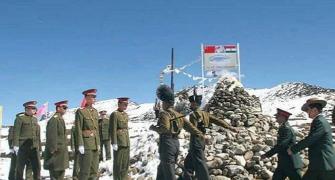'In Ladakh, both India and China are evenly matched.'
'This leaves unanswered the question: Why this aggression now?' asks Colonel Anil A Athale (retd) before giving us the answer.

The tragic loss of life of Indian soldiers -- including the commanding officer of a battalion -- has brought India and China to the brink of a shooting war.
At the time of writing there is no definitive information about the Chinese losses.
But unconfirmed reports based on American intelligence sources claim these to be almost equal to the Indian losses.
Amidst all this military tension, there is no clarity what are the Chinese strategic and tactical aims in initiating this crisis at this time!
In an earlier column I had drawn attention to the fact that China may well be trying to cash in on the global disarray caused by the COVID-19 pandemic.
The other explanation is that it is a result of an internal power struggle within the Chinese Communist Party where an anti Xi JinPing faction, with the help of the People's Liberation Army, is creating trouble.
While the Chinese actions on the Indian border are going on, Beijing has also activated its proxy regime in Nepal to further needle India.
North Korea is also on the offensive and there is confrontation building in the South China Sea as Beijing has declared it a 'district' of the People's Republic of China.
These actions could well be China's pre-emptive response to the likely post COVID-19 global isolation of China -- an event that could damage its economy and evaporate its dream of becoming a superpower.
The above prognosis may sound outlandish at first reading, but is it really so? The last three global viral outbreaks originated in China.
The present one is the most devastating.
The world cannot afford a China periodically spewing dangerous viral particles.
All policies -- whether American, European or Asian -- will be centered around containing this risk from China.
This will invariably lead to economic and geographic isolation of China by the international community.
The issue is the way China is ruled, and the policies it follows.
It is happy to restrict anything that it sees fit, while demanding access from others.
Last year around September I travelled with the family to Ladakh as a 'tourist', the occasion was to celebrate 50 years of my army career that began in Dorbuk in Ladakh.
It was indeed an eyeopener. Leh, formerly a sleepy small town, was now a bustling city.
We went to the far edge, to Turtuk in the Nubra Valley and then took the direct road to Dorbuk.
This entire journey was done in an ordinary car.
We also drove to the Pangong Tso lake to take in the absolutely surreal and stunning scenery.
Without violating military secrecy, suffice to say that there were ten times more troops in Ladakh and a hundred times better equipment.
It was a far cry from fifty years ago and certainly no comparison with the bleak days of 1962!
The end of June will see the opening of the Rohtang Tunnel on the Manali-Leh route that will open up access to Ladakh round the year.
The distance for logistics supply will be reduced by 300 km and it will be possible to bypass the six month snow bound Zozila Pass and turbulent Kashmir valley.
The airfields at Thoise, and Leh and the air strip at Daulat Beg Oldie in conjunction with acquisition of C-130 Hercules aircraft and Chinook heavy lift helicopters have given the Indian Army tactical mobility.
The Indian advantage in air power of bases being at the sea level and within range of fighters, though diluted somewhat, is yet significant.
Luckily for India and despite the Chinese provocation, Prime Minister Modi has refused to comment on the crisis.
As a military historian, one is painfully aware of Prime Minister Nehru's disastrous statement on September 12, 1962: 'I have asked the Indian Army to throw out the Chinese', which proved to be the last straw for the Chinese.
Neville Maxwell, in his otherwise biased and pro-Chinese account of the 1962 War, had nevertheless made one very accurate observation on Nehru's China policy.
According to him, India blundered into the 1962 conflict 'when a clueless government was goaded into unviable military action by uninformed and inflamed public opinion'.
While India in 2020 is a far cry from India of 1962, the hullabaloo over the India-China standoff has sparked off uninformed comments by Opposition leaders and armchair strategists. Some retired military men have added to the confusion.
Sinophile diplomats has also joined the fray to again paint the picture of 'superpower' China and a 10 feet tall Chinese soldier.
Both are far from reality.
As someone who has had the opportunity to have a worm's eye view as a soldier and a bird's eye view as a historian, it is time to get some clarity.
Today, India and China are evenly matched on the border.
The various road projects India has implemented in the last six years has ensured that we are a match in tactical mobility, movement between battlefields (like DBO and Pangong Tso) thanks to the road described above.
With the opening of the Rohtang Tunnel and the acquisition of aircraft like the C-130 we have strategic mobility and the ability to move troops between theatres, say from Punjab to Ladakh.
The Chinese have always had the tactical advantage of being on the plateau and have improved strategic mobility with the China Tibet rail link.
But with its military bases over 2,000 km away it has to bear the huge economic costs of maintaining forces on the Indian border.
When one talks of military balance, one has to take into account not the overall strength, but the numbers that can be brought to a particular front.
In Ladakh, both India and China are evenly matched.
This leaves unanswered the question: Why this aggression now?
Given the kind of political capital Xi Jinping has invested in better India-China relations, the impression seems unmistakable that the current target is not just India, but Xi Jinping himself.
Colonel Anil A Athale (retd) is the co-author of the official history of the India-China conflict of 1962.
Production: Aslam Hunani/Rediff.com









